5 Simple Steps to Fall Vegetable Planting (an easy how to)
Let’s face it, everyone loves the dog days of summer. But having to say goodbye to our once glorious vegetable garden is HARD.
The good news is that summer doesn’t mean it’s all over! You CAN create a second vegetable garden in the fall – full of delicious, nutritious vegetables to take you right to Thanksgiving. In fact, some gardeners actually prefer to plant their vegetables in the fall. And not just because of the ease of working in cooler weather, they also claim that some of the vegetables actually taste better after a light frost.
Want to give it a try?
Here’s how:
1. Start with a Plan
Before ordering your fall vegetable plants, take a moment to look at your current garden space.
Of course there will be vegetables you planted in the spring or early summer that are still producing. But there will be many that don’t tolerate the dog days of summer well and will have quit fruiting or growing by mid-July and into August.
Time to clean house! Pull up everything that’s just taking up space. Determinate tomatoes and early lettuce will definitely be on this list. Weed well, remove any overgrown plants from these areas, turn the soil, then stand back and take stock.
Now you know exactly where you have room to plant. (You might even want to make yourself a list so that when your plants arrive, you don’t have to try to remember where you wanted to plant what – we’ve all been there!).
2. Know Your First Average Frost Date
Because frost kills many vegetables, knowing your average first fall frost date is critical for successful fall gardening.
You can think if your first frost date as your ‘growing deadline’. And the first fall frost date differs, depending on your region.
To get the average first frost date in your area, simply go to this link and type in your ZIP Code.
Once you have this date, count backwards from today. This is your number of frost free days you have to grow a fall garden. Write down this number as it will be needed for the upcoming steps.
3. Know the Maturity Times
When choosing your vegetable plants for your fall garden, take note of the days to maturity (which is how many days a plant needs to grow before its ready to be harvested).
Because fall plants generally have less sun and heat than those grown in the summer, you should add 10 extra days onto the numbers of days of maturity.
So, if a plant has a maturity date of 50 days, you will need to plan for 60 days to ensure a good harvest.
4. Plant Hardiness
Plants for fall gardens have classifications of; tender, semi-hardy, and hardy.
Tender veggies will not withstand the first frost (31-33 degrees F.) and must be harvested beforehand. Some of these would be beans, cucumbers, eggplants, melons, okra, peppers, pumpkins, squash, sweet corn, sweet potatoes, and tomatoes.
Semi-hardy veggies will withstand light frosts (26-31 degrees F.) but must be harvested before a “hard” frost (temps below 25 degrees). Some of these would be beets, broccoli, cabbage, carrots, cauliflower, lettuce, parsley, and radishes.
Hardy veggies can withstand hard frosts/freezing temps, so the frost date is not as important for these varieties. Some of these would be brussels sprouts, collards, kale, kohlrabi, and turnips. They should be harvested before temps drop to 15 degrees F.
Still a bit confused? You can look up any plants hardiness using this chart.
5. Consider Both Maturity Time + Plant Hardiness
It’s best to consider maturity time and plant hardiness simultaneously because they play off of each other.
For example, maturity time is crucial when growing tender plants because these will die with the first frost. For these varieties, use the number of frost-free days and their maturity dates to determine if you have time to grow them.
For the semi-hardy plants, you don’t need to add on the extra 10 days, just use the maturity date that is indicated.
In contrast, the date by which hardy plants will mature is less critical because they keep right on growing despite the freezing weather. These can be planted up to two weeks later than your tender crops.
It’s Planting Time!
Once you’ve followed these five steps, it’s easy to plan a fall vegetable garden with as much precision as the pros. Just pull up your calendar and figure out when the starter plants you’re interested in will reach maturity based on the date you intend to plant them.
And the last step, of course, is to choose your veggies – you can browse our selection here.
Questions?
You can contact us HERE.
From all of us at GrowJoy: happy planting!






3 Comments
Josie
November 9, 2010 at 11:59 amThis really pulled together some info I’ve been needing. Thanks.
jstutzman
November 18, 2010 at 6:20 pmYou are most welcome!
Tim
October 1, 2015 at 1:54 pmThanks for the information. I have been wanting to try my hand at fall planting. These articles should get me going in the right direction. Thanks!